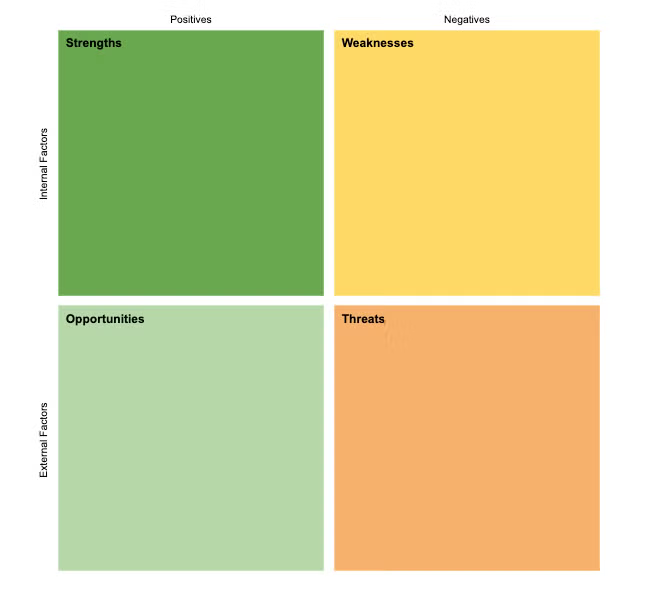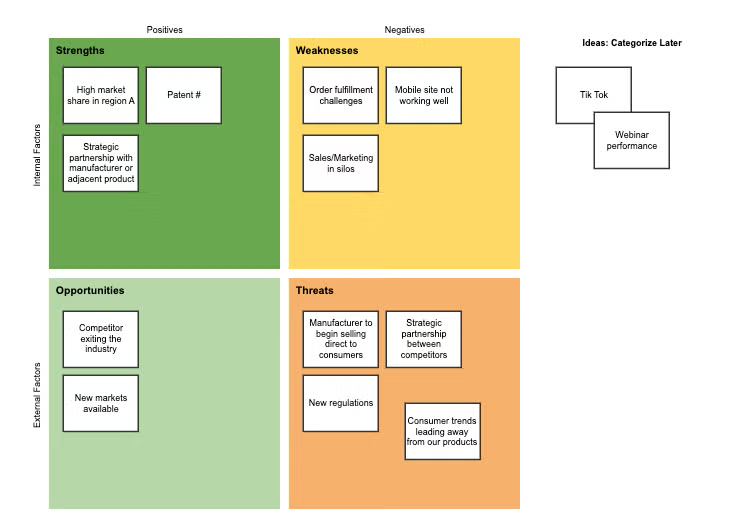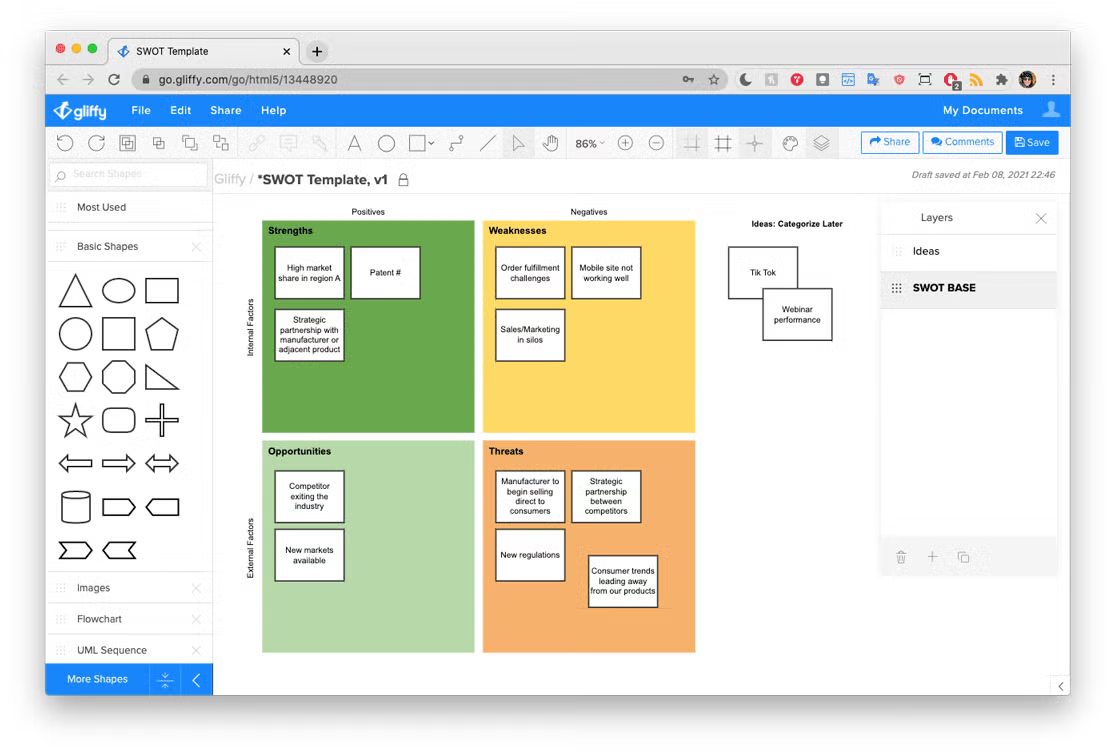Whether you’re starting your own business or are a member of a corporate team, knowing how to do a SWOT analysis is a valuable skill. It can help you understand the competition your business faces or prioritize your organization’s goals. If you’re not familiar with the Strengths-Weaknesses-Opportunities-Threats framework yet, read up on our Guide to SWOT analysis. Here, we’ll focus specifically on how to do a SWOT analysis.
You can do a brainstorming session for your SWOT analysis on a whiteboard, with sticky notes, or in Gliffy’s online diagramming tool. With Gliffy, you’ll be able to save and capture your ideas — and our sticky notes are unlimited.
Follow along with this tutorial by signing up for a free trial of Gliffy for Confluence >>
Video SWOT Tutorial: How to Do a SWOT Analysis in Gliffy
How to Complete a SWOT Analysis Anywhere
Step 1: Set Up Categories for Strengths, Weaknesses, Opportunities, and Threats
These are the four categories you’ll organize your information and ideas into. You can create a side-by-side structure with four rows or columns, or you can organize the categories into a matrix. In this case, you’d place strengths and weaknesses in the top row of your 2x2 box, then opportunities and threats below it. You can save time by jumping past this step with Gliffy’s free SWOT template.

Step 2: Brainstorm Strengths
These are the things your company or organization excels at, like having the highest-rated tool on the market or being known for excellent customer service. If you aren't sure what your company's competitive advantage is, a value chain analysis can help you identify it and map out ways to improve it. Strengths can also be physical things that support your business, like your location or patents that you hold.
Step 3: Identify Weaknesses
Weaknesses are the things that your competitors are doing better than you or the things that your company doesn’t have, which are hurting your business. This could be things like having limited business hours compared to your competitors or an issue with your product.
Step 4: Pinpoint Opportunities
Instead of thinking specifically about your company, opportunities invite you to consider the competitive landscape or external forces on your business. If you own a restaurant in an area where a developer just broke ground on a large apartment complex, that could create a change in demand. This would be a great opportunity for your business. Or if you have an online resource business like Studocu, you might want to look into potential alliances with institutions or companies that can benefit your growth.
Other examples of opportunities might be weaving a new technology into your business model or identifying a new application or audience for your product.
Step 5: Look for Threats
Threats to your business will be external factors that could hurt your bottom line. These might be changes in laws and regulations, a new technology that undermines the need for your product, or new competitors entering the environment. If you've ever done a PEST analysis, you already have the information you'll need to identify some of these threats, as well as certain opportunities.

Step 6: Rearrange and Clarify Ideas
The most common mistake while making a SWOT analysis is confusing strengths with opportunities or weaknesses with threats. Remember that strengths and weaknesses are internal to your business — they’re things you can proactively work toward. Opportunities and threats, on the other hand, are external to your organization and will be things you likely need to react to.
But, depending on how you frame an idea for your SWOT diagram, you may decide to move it from one category to another. Our SWOT templates include a spot to put ideas. This spot is perfect for things that come up during your conversations, but don’t have the context to fit in a certain category yet. Getting feedback from your coworkers or peers is important for this step.
This is also where Gliffy can help. You can use an online SWOT tool like Gliffy and share your screen, embed a live version of your chart in Slack, or invite your coworkers to edit or leave comments on your diagram.
Step 7: Finish Your Analysis With Actionable Feedback
This step is easily (and often) skipped, but it’s actually the most important step as you learn how to do a SWOT analysis. Capturing strengths, weaknesses, opportunities, and threats in a SWOT template isn’t actually completing an analysis. The last step is to use the information you’ve mapped to provide clear recommendations or ideas for your organization.
Strength & Opportunity Recommendations
Evaluate the strengths and opportunities you identified. How can you address opportunities in the competitive environment while using your strengths?
If your company has great manufacturing relationships for its small appliances, new consumer demand you noticed for a similar product could be a great opportunity to pursue. You may not be able to act on every opportunity, so this will help you prioritize.
Weakness & Opportunity Recommendations
With the opportunities you’ve spotted, how will your company’s weaknesses show up? What can you do to address those weaknesses in order to take advantage of the new opportunities?
For example, your company might have identified a potential second location, but also have multiple positions open at your current location and need more help there. Opening a second location while still struggling to get the support staff needed for your first is strategically not a great fit for your company. If your company can address the staffing issue at the first location, opening a second location becomes a much more appealing opportunity.
Strength & Threat Recommendations
How can you use your organization’s strengths to fend off the threats you identified? Brainstorm possible solutions to effectively mitigate or react to those threats based on your strengths.
Say one of your organization’s strengths is your high market share and customer loyalty in a particular neighborhood. You’ve identified a threat: one of your competitors is going to open a location in that same neighborhood. Using your market share and customer loyalty, how could you ensure that you don’t start losing customers
Weakness & Threat Recommendations
Based on the weaknesses you identified, which threats are particularly dangerous for your organization? This might help you prioritize how you’ll address your list of weaknesses.
Slow shipping or a bad process for order fulfillment might be a weakness you identified. If a new entrant in your industry has created a same-day delivery format for their products, addressing your own delivery challenges would be important.

Back to top
Get Started with a SWOT Template
Using a SWOT template in Gliffy will save you set-up time and make it easy to save and revisit older versions of your framework. Start your free trial of Gliffy for Confluence today to get started.